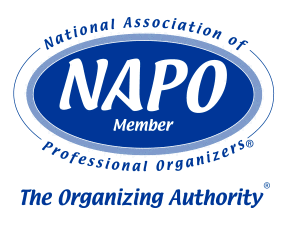 The holidays are nearly behind us, but there’s possibly one more thing most of us need to do . . . . pack it up!
The holidays are nearly behind us, but there’s possibly one more thing most of us need to do . . . . pack it up!
Tackling this task can either be liberating or daunting, depending on how organized and prepared we are. Here are some thoughts on making it easier, if not this year, certainly in years to come.
- Reduce, reduce, reduce: It’s always easier to pack away less stuff, so I suggest my clients take a good, long look at what they are planning to pack away. A couple questions to ask yourself:
- Do you or someone in your home love it? If it holds great memories and you decorate with it every year, pack it up.
- Has it been trapped in a storage container year-after-year-after-year? If that’s the case, it’s probably not your style and doesn’t hold great memories. Give it away. Someone else will probably cherish it.
- Give it away:
- Has someone you know admired the decoration? Ask them if they want it. Gifting items to someone who has admired them is an easy way to release things that no longer serve us.
- Is there a local charity, church, etc. that cold use the item? Gifting things to those that can’t afford them brings extra honor to the decorations. (NOTE: Most charities will gladly accept Christmas decorations even at the end of the season, but it’s best to check before you try to drop them off.)
- Store it: There are nearly as many ways to store decorations as there are decorations themselves!
- Specialty containers like these from the Container Store can be extremely functional, but not very cost-effective.
- Other simple solutions:
- Wrap lights around cardboard, use a extension cord holder, or for larger quantities, utilize a hose reel. Check it out.
- Liter-size water bottles work well to hold beaded garland.
- Plastic produce clam-shell containers from warehouse stores are fantastic for glass ornaments.
- Egg cartons work well for small, breakable ornaments.
- Traditions: What traditions served you well this year? Did everyone still enjoy trekking into the woods for the Christmas tree? Was neighborhood caroling a big hit? Midnight/sunrise service still magical? If so, plan it again for next year. If not, let it go. No need to carry on traditions “just because.”
- Holiday Cards: Be sure to keep track of who you received holiday cards from this year and add them to your 2017 holiday card list. If you still have the envelopes, double-check the addresses to ensure your records are up-to-date.
Going through the sort, purge, and store process probably isn’t the most fun thing you will do this holiday season, but it could very well be the best gift you could give yourself come holiday time next year!
Happy New Year, everyone!
Cindy Jobs










